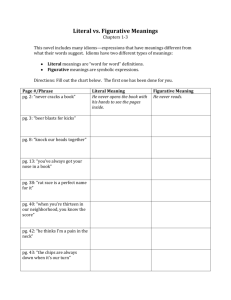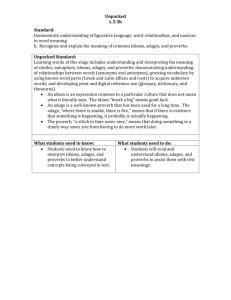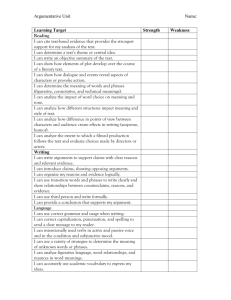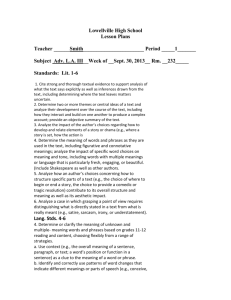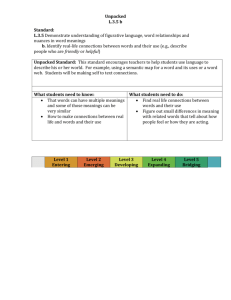Language L5
advertisement
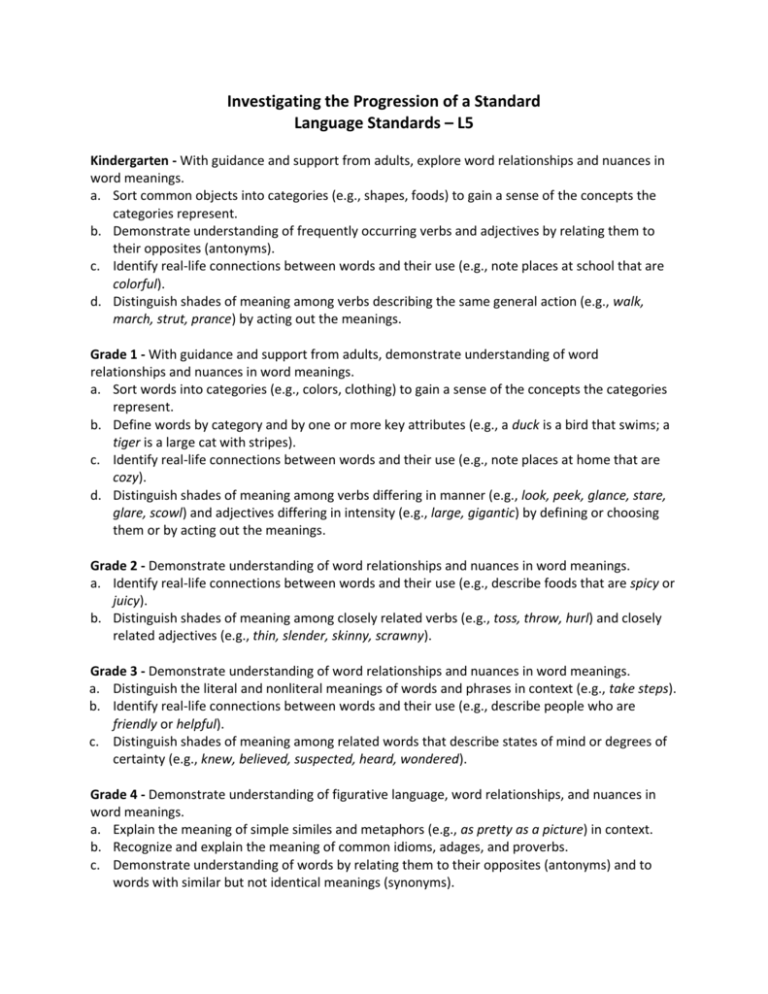
Investigating the Progression of a Standard Language Standards – L5 Kindergarten - With guidance and support from adults, explore word relationships and nuances in word meanings. a. Sort common objects into categories (e.g., shapes, foods) to gain a sense of the concepts the categories represent. b. Demonstrate understanding of frequently occurring verbs and adjectives by relating them to their opposites (antonyms). c. Identify real-life connections between words and their use (e.g., note places at school that are colorful). d. Distinguish shades of meaning among verbs describing the same general action (e.g., walk, march, strut, prance) by acting out the meanings. Grade 1 - With guidance and support from adults, demonstrate understanding of word relationships and nuances in word meanings. a. Sort words into categories (e.g., colors, clothing) to gain a sense of the concepts the categories represent. b. Define words by category and by one or more key attributes (e.g., a duck is a bird that swims; a tiger is a large cat with stripes). c. Identify real-life connections between words and their use (e.g., note places at home that are cozy). d. Distinguish shades of meaning among verbs differing in manner (e.g., look, peek, glance, stare, glare, scowl) and adjectives differing in intensity (e.g., large, gigantic) by defining or choosing them or by acting out the meanings. Grade 2 - Demonstrate understanding of word relationships and nuances in word meanings. a. Identify real-life connections between words and their use (e.g., describe foods that are spicy or juicy). b. Distinguish shades of meaning among closely related verbs (e.g., toss, throw, hurl) and closely related adjectives (e.g., thin, slender, skinny, scrawny). Grade 3 - Demonstrate understanding of word relationships and nuances in word meanings. a. Distinguish the literal and nonliteral meanings of words and phrases in context (e.g., take steps). b. Identify real-life connections between words and their use (e.g., describe people who are friendly or helpful). c. Distinguish shades of meaning among related words that describe states of mind or degrees of certainty (e.g., knew, believed, suspected, heard, wondered). Grade 4 - Demonstrate understanding of figurative language, word relationships, and nuances in word meanings. a. Explain the meaning of simple similes and metaphors (e.g., as pretty as a picture) in context. b. Recognize and explain the meaning of common idioms, adages, and proverbs. c. Demonstrate understanding of words by relating them to their opposites (antonyms) and to words with similar but not identical meanings (synonyms). Grade 5 - Demonstrate understanding of figurative language, word relationships, and nuances in word meanings. a. Interpret figurative language, including similes and metaphors, in context. b. Recognize and explain the meaning of common idioms, adages, and proverbs. c. Use the relationship between particular words (e.g., synonyms, antonyms, homographs) to better understand each of the words. Grade 6 - Demonstrate understanding of figurative language, word relationships, and nuances in word meanings. a. Interpret figures of speech (e.g., personification) in context. b. Use the relationship between particular words (e.g., cause/effect, part/whole, item/category) to better understand each of the words. c. Distinguish among the connotations (associations) of words with similar denotations (definitions) (e.g., stingy, scrimping, economical, unwasteful, thrifty). Grade 7 - Demonstrate understanding of figurative language, word relationships, and nuances in word meanings a. Interpret figures of speech (e.g., literary, biblical, and mythological allusions) in context. b. Use the relationship between particular words (e.g., synonym/antonym, analogy) to better understand each of the words. c. Distinguish among the connotations (associations) of words with similar denotations (definitions) (e.g., refined, respectful, polite, diplomatic, condescending). Grade 8 - Demonstrate understanding of figurative language, word relationships, and nuances in word meanings a. Interpret figures of speech (e.g. verbal irony, puns) in context. b. Use the relationship between particular words to better understand each of the words. c. Distinguish among the connotations (associations) of words with similar denotations (definitions) (e.g., bullheaded, willful, firm, persistent, resolute). Grades 9-10 - Demonstrate understanding of figurative language, word relationships, and nuances in word meanings. a. Interpret figures of speech (e.g., euphemism, oxymoron) in context and analyze their role in the text. b. Analyze nuances in the meaning of words with similar denotations. Grade 11-12 - Demonstrate understanding of figurative language, word relationships, and nuances in word meanings. a. Interpret figures of speech (e.g., hyperbole, paradox) in context and analyze their role in the text. b. Analyze nuances in the meaning of words with similar denotations. Language Standards – L5

